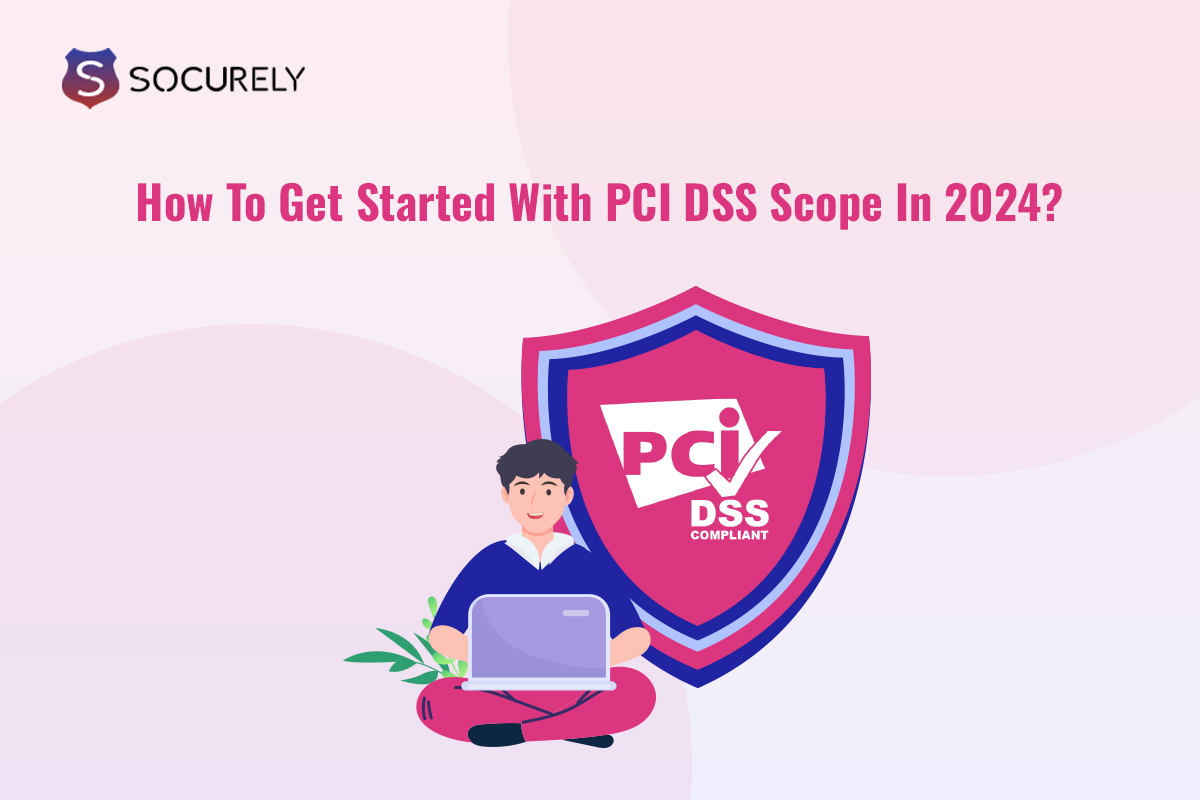“There is no such thing as a security product; it is a process.” – Bruce Schneier
PCI DSS (Payment Card Industry Data Security Standard) has become the global benchmark for businesses handling cardholder information. However, understanding the PCI DSS scope is often one of the first, and most essential, steps to achieving compliance.
According to PCI scope, your Cardholder Data Environment (CDE) must comply with all 12 PCI Data Security Standard (DSS) standards. Understanding PCI DSS regulations, controls, and which systems need to be secured can be challenging for many firms.
If you’re starting your compliance journey in 2024, getting your PCI DSS scope right from the start will not only save time and resources but also help protect sensitive data more effectively.
Let’s examine the extent of the PCI DSS and its coverage in more detail.
What Is a PCI DSS Scope?
PCI DSS scope refers to the specific systems, networks, and processes within your organization that handle, store, or transmit payment card data. Simply put, it’s everything in your environment that touches cardholder data (CHD) or sensitive authentication data (SAD), and it needs to be properly protected according to PCI DSS requirements.
Accurately defining your PCI DSS scope is vital because it directly impacts the breadth and depth of your compliance efforts. A poorly defined scope can lead to unnecessary work and costs, or worse—non-compliance. The goal is to minimize the scope by isolating the systems that need to comply with the standard while maintaining strong security controls.
Networks and Internal Systems
Everything that is considered “in scope” for PCI DSS Compliance includes any assets that handle, transmit, or store credit card data. CDE is applied to all system components that handle, store, or transfer credit card data.
All companies that handle credit cards, such as issuers, processors, merchants, and service providers, must adhere to the PCI DSS security standards. Processes, people, and technology that handle, store, or transport cardholder data or sensitive authentication information make up the cardholder data environment (CDE).
Providers of Services and Other External Parties
The scope of PCI DSS includes all business partners, companies that offer remote support services, and other service providers that are either linked to the cardholder data environment (CDE) or might compromise an entity’s CDE.
Key Components Within PCI DSS Scope
When determining your PCI DSS scope, it’s essential to focus on several critical elements that interact with payment card data. These include:
- Cardholder Data Environment (CDE): The systems, devices, applications, and networks that store, process, or transmit CHD.
- Connected Systems: Any system connected to the CDE, even if it does not handle CHD directly.
- Third-Party Providers: External services or vendors that may process or store card data on your behalf.
- Data Flow: Understanding how payment card information moves within your organization will help ensure everything that needs to be in scope is covered.
Types Of PCI DSS Scope-
In general, the PCI DSS Scope is categorized into 3 types-
Within-scope
Systems that have a direct bearing on, are linked to or are somehow associated with cardholder data security. To determine if each requirement applies, they must be evaluated about all PCI DSS standards.
Outside the Scope
Systems without any kind of access to the cardholder data environment; if a system does have access, it falls inside the scope. Since there is no guarantee that these systems have been adequately protected, they are viewed as public or untrustworthy.
Controls must be in place to prevent the out-of-scope system from gaining access to the CDE through the in-scope systems if it is linked to or has access to a security-influencing system via the same network (or VLAN or subnet).
Connected Scope
PCI DSS also covers systems that are linked to the CDE but are not directly engaged in handling card information or transactions. Systems are included in the scope to verify that the relevant security measures are in place, even in cases where a connection is restricted to certain services or ports on particular systems. Furthermore, there cannot be an access channel made available from CDE systems to out-of-scope systems.
Why Is Defining PCI DSS Scope Important?
Defining your PCI DSS scope is crucial for several reasons:
- Cost Efficiency: A clear, well-defined scope helps you avoid applying security controls to unnecessary systems, reducing the cost and complexity of compliance.
- Focused Security: By isolating systems and networks that handle CHD, you can concentrate security efforts on protecting sensitive data.
- Audit Readiness: A properly scoped environment ensures that your PCI DSS audits will be more streamlined and less stressful.
How To Create PCI DSS Scope: Step-by-Step Guide
Creating an accurate and manageable PCI DSS scope in 2024 requires careful planning and execution. Follow this step-by-step guide to ensure your scope is well-defined and compliant:
Identify Cardholder Data Flow
Start by mapping the flow of cardholder data throughout your organization. Ask yourself:
- Where is card data being captured?
- How is it stored, processed, or transmitted?
- What systems, networks, or third parties have access to this data?
Tools such as data flow diagrams can help visually represent this process, making it easier to see where card data travels and where security controls are necessary.
Segment the Network
Network segmentation is a critical practice that helps reduce the PCI DSS scope by isolating systems that handle CHD from those that don’t. By segmenting your network, you can reduce the number of systems that fall under PCI DSS compliance, making it easier to manage and secure your environment.
Review and Include Third-Party Services
If you work with third-party providers, such as payment processors or cloud services, they must be included in your scope if they store, process, or transmit CHD on your behalf. Ensure you have clear contracts and service-level agreements (SLAs) that outline their role in your PCI DSS compliance.
Identify All Connected Systems
Any system connected to your Cardholder Data Environment (CDE), even if it doesn’t handle card data directly, must be included in the scope. These connected systems could be a point of attack, so include them to ensure they are appropriately secured.
Minimize the Scope
Once you’ve identified everything within your potential scope, you can take steps to minimize it. Strategies like tokenization, encryption, and outsourcing payment processing to PCI DSS-compliant vendors can help you reduce the number of systems that need to be secured and monitored.
Document Your Scope
Lastly, document everything. Having clear, up-to-date documentation of your scope will not only help during PCI DSS audits but will also keep your internal teams aligned and focused on protecting the right assets. This documentation should include:
- Data flow diagrams
- System inventories
- Network segmentation details
- Third-party vendor agreements
Common Challenges in Defining PCI DSS Scope
Even with a clear process, scoping for PCI DSS compliance can present challenges. Some common obstacles include:
- Over-scoping: Including too many systems or networks in your PCI DSS scope can make compliance more complex and expensive.
- Under-scoping: Missing key systems or third-party vendors can lead to gaps in security, leaving sensitive data vulnerable.
- Inconsistent Data Flow: Lack of visibility into where and how CHD moves through your organization can result in incomplete scoping.
To avoid these pitfalls, regularly review and update your scope to reflect any changes in your systems, network architecture, or business processes.
Why Is PCI DSS Scope Critical In 2024?
As cyber threats continue to evolve, PCI DSS scope remains critical to your organization’s data security strategy. The increasing complexity of business environments, including hybrid work setups, cloud infrastructure, and expanding vendor networks, makes it more important than ever to accurately define and manage your scope.
Staying up-to-date with the latest PCI DSS versions and industry trends will help ensure that your organization not only remains compliant but also provides the highest level of protection for cardholder data.
Get Started With Socurely
Having a PCI attestation of compliance certificate or an equivalent testimony of PCI DSS compliance is crucial for every firm that interacts with or handles Cardholder Data or CHD.
Business demands demand that a company become PCI compliant, but doing so on your own is difficult given the more than a dozen security criteria and 300 strict security controls that must be followed. This requires a large investment of an organization’s time and money.
With Socurely, your firm can automate PCI compliance, save hundreds of hours on the compliance process, satisfy all operational control requirements, and adopt best practices for security.
Get in contact with us right now to find out more about how Socurely can assist your company in achieving and maintaining PCI compliance.
Conclusion
Getting your PCI DSS scope right is the foundation of your compliance efforts. By taking the time to properly map data flow, segment your network, and include third-party providers, you can significantly reduce the complexity and cost of compliance while enhancing your overall security posture. Remember, compliance is not just a checkbox exercise—it’s an ongoing process that protects both your organization and your customers.
As you move forward in your PCI DSS journey in 2024, following these best practices will help you stay compliant, minimize risks, and ensure that your systems are secure.
FAQ
How To Calculate My PCI DSS Scope?
To calculate your PCI DSS scope, identify all systems, processes, and networks that store, process, or transmit cardholder data. This includes reviewing data flows, network segmentation, and third-party services that interact with payment card information. Accurate mapping is essential to ensure compliance and security.
What Should Not Be In PCI DSS Scope?
Systems that do not interact with cardholder data (CHD) or sensitive authentication data (SAD) should not be included in your PCI DSS scope. This could include administrative or operational systems unrelated to payment processing, reducing the complexity and cost of compliance efforts.
What Systems Are Considered In Scope?
Systems that store, process, or transmit cardholder data are considered in scope for PCI DSS compliance. Additionally, any system that connects to or supports the Cardholder Data Environment (CDE), including those that provide security services or communication paths, must be included in the scope.
What Systems Are Out Of Scope?
Systems that have no interaction with cardholder data or the Cardholder Data Environment (CDE) are typically out of scope for PCI DSS. These may include isolated networks, non-payment systems, or administrative services that do not affect the flow or security of payment card information.







